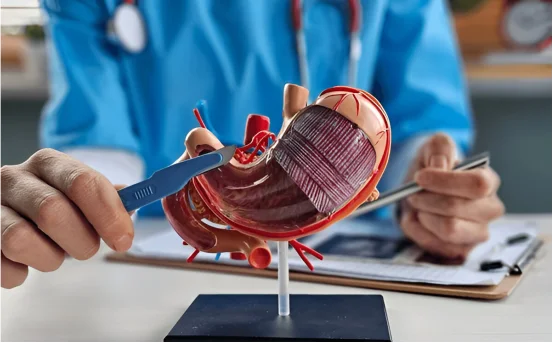Heart disease is one of the most prevalent causes of death worldwide and coronary artery diseases (CAD) as the one that is most common. As medical science advances new techniques such as Hybrid Coronary Revascularization Surgery (HCRS) are reshaping the way we deal with this deadly disease.
Hybrid Coronary Revascularization Surgery is an advanced cardiovascular procedure that combines two proven techniques–minimally invasive coronary artery bypass grafting (CABG) and percutaneous coronary intervention (PCI). Utilizing the advantages of both catheter- and surgical techniques, HCRS offers a patient-friendly and less invasive option to open-heart surgery as a traditional procedure.
This procedure is particularly beneficial for patients suffering from multiple coronary artery disease in particular when one arterial (typically the LAD-left anterior ascending) requires bypass, while other are better off with stenting. With shorter recovery times, less complications, and improved results, HCRS is becoming a most popular option in a number of heart hospitals.
Why Is Hybrid Coronary Revascularization Surgery Performed?
Hybrid Coronary Revascularization Surgery is usually performed on patients suffering from coronary artery diseases with blockages that are complex within multiple arterial arteries. The purpose of surgery is to bring blood flow back into the heart and prevent the occurrence of future cardiac events, such as cardiac attacks and increase the overall function of the heart and overall quality of life.
Here’s the reason HCRS could be a good option:
-
Minimally Invasive Method It eliminates the necessity of a full surgery called sternotomy (chest opening) and results in less discomfort, quicker healing and lower risk of infection.
-
Optimized Treatment Strategies It is said that the LAD artery commonly known as”the “widow-maker,” receives a bypass and less complicated blockages are treated by stents that ensure a the most effective and precise treatment.
-
Better outcomes Combining both strategies could result in better short-term as well as long-term results especially for older or high-risk patients.
Symptoms Leading to Hybrid Coronary Revascularization Surgery
People who have the hybrid procedure of coronary revascularization typically exhibit signs that are indicative of the coronary artery for example:
-
Angina or chest pain (especially during exercise)
-
Breathlessness
-
Fatigue
-
Heart palpitations
-
Feeling faint or dizzy
-
Swelling of feet or legs
-
Reduced tolerance to exercise
The symptoms are caused by the insufficient flow of blood caused by plaque accumulation in coronary arteries which reduces oxygen flow for the muscle of your heart.
Causes for Hybrid Coronary Revascularization Surgery
The main reasons leading to the necessity for an interdisciplinary coronary revascularization typically are:
-
Atherosclerosis The most frequent cause is when fatty deposits (plaques) accumulate in the walls of the artery.
-
The high blood pressure causes damage to blood vessels over time, leading to shrinking.
-
The levels of cholesterol are high. LDL cholesterol levels are excessive. This increases the risk of plaque formation.
-
Smoking causes blood vessels to be damaged and increases the risk of coronary arteriac disease.
-
Diabetes is a risk factor that increases risk by altering how the body process glucose.
-
Sedentary and overweight living is associated with multiple heart risk factors.
-
Genetics Family history is a major factor in the development of heart problems.
When these risk factors grow unchecked, they can cause multiple arterial blockages, which makes an combination method an effective method of treatment.
Diagnosis for Hybrid Coronary Revascularization Surgery
Before making a recommendation for the hybrid procedure of coronary revascularization an extensive examination is performed to determine the severity of arterial blockage as well as heart function. The most commonly used diagnostic tests are:
-
ECG (ECG): Detects irregularities in the heart rhythm as well as symptoms of previous heart attacks.
-
Stress Test The test measures the performance of the heart in the face of physical strain.
-
Echocardiogram uses ultrasound to see the heart’s function and structure.
-
Cardiac CT also known as MRI offers detailed images of blood vessels and the heart’s tissues.
-
Coronary Angiography: A reliable test using X-rays and contrast dye to detect the blockages in coronary arteries.
These tests aid cardiologists and surgeons to decide whether an HCRS procedure is the appropriate treatment and if the combination of bypass and stenting is more beneficial than conventional surgery or PCI all by itself.
Treatment: The Hybrid Coronary Revascularization Procedure
Step-by-Step Overview
Hybrid Coronary Revascularization Surgery is typically performed in the Hybrid Operating Room that is a combination of surgery and catheterization capabilities of the lab.
-
Minimally Invasive CABG (LAD Bypass)
-
An incision of a small size is cut (usually between the ribs) to gain access to the heart.
-
It is the left mammary arterial (LIMA) is grafted onto the LAD artery.
-
There is no need to use a the heart-lung machine for many situations (off-pump procedure).
-
-
Percutaneous Coronary Intervention (PCI)
-
A catheter is inserted in an artery that is peripheral to the body (usually the groin or wrist).
-
Balloon angioplasty and the placement of stents are utilized to widen narrowed arteries.
-
-
Staged or Simultaneous Approach
-
PCI can be performed prior to, after, or even during the same procedure as bypass, based on the patient’s requirements and the setting of the hospital.
-
Post-Surgical Care & Recovery
-
Hospitalization The typical hospital stay is 3 to 5 days, less that traditional bypass.
-
Recuperation Time The majority of patients return to regular activities within two to four weeks.
-
Cardiac Rehab: Customized programs to help with physical recovery along with lifestyle training.
-
Medication blood thinners, beta blockers, and cholesterol-lowering medicines are often prescribed.
Benefits of Hybrid Coronary Revascularization Surgery
-
Less Invasive Than Open-Heart Surgery
-
Faster Recovery and Reduced Hospitalization
-
Lower Risk of Infection and Complications
-
Improved Long-Term Heart Function
-
Tailored to Complex Coronary Disease Cases
Conclusion
Hybrid Coronary Revascularization Surgery is a major breakthrough for the management of complicated coronary artery problems. Combining the advantages that traditional bypass surgeries with advanced interventional cardiology This approach provides personalized, effective and safe treatment for patients with heart disease.
If you or someone in your family is suffering from multi-vessel coronary artery disease, and seeks an less invasive, targeted approach discuss with your cardiologists regarding the hybrid coronary revascularization procedure. It may be the life-saving solution you’ve been looking for to build an improved heart, and a healthier one.






















